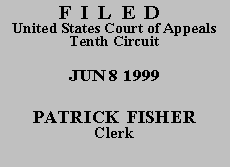

| PANSY K. MARSHALL,
Plaintiff-Appellant, v. KENNETH S. APFEL, Commissioner, Social Security Administration, Defendant-Appellee. |
|
Claimant Pansy K. Marshall appeals from an order of the magistrate judge, sitting for the district court by consent of the parties pursuant to 28 U.S.C. § 636(c), affirming the decision of the Commissioner of Social Security that she is not disabled and, thus, not entitled to social security disability benefits. We have jurisdiction under 28 U.S.C. §§ 636(c)(3), 1291 and 42 U.S.C. § 405(g), and we affirm.
Claimant applied for benefits in 1995, when she was 47, alleging disability due to paralysis on the right side of her body, Bell's palsy on her left side, vision loss, high blood pressure, and kidney and gallbladder problems. Claimant has a high school education. Her right arm and hand have been paralyzed since 1967. She had a good work history between 1972 and 1995 as a file clerk and photocopier even though she could use only her left hand. She developed Bell's Palsy in December 1994, which affected the left side of her face and took a few months to resolve. Although claimant alleged disability due in part to vision loss, she reported that her vision was normal with glasses and could see to drive, read, and watch television. She also suffered from poorly controlled hypertension, sinusitis, and bronchitis. She is overweight and suffers low back pain and was diagnosed with degenerative joint disease. Claimant also testified that she has emotional problems due to her divorce in 1976 and her mother's death in 1979, and was prescribed anti-depressant medication the day before the administrative hearing.
The administrative law judge (ALJ) denied benefits at step four of the five-part sequential process for determining disability. See Williams v. Bowen, 844 F.2d 748, 750-52 (10th Cir. 1988) (discussing five-step process). The ALJ determined that claimant retained the residual functional capacity to perform light work and could return to her past relevant work as a file and photocopy clerk. The ALJ therefore concluded that claimant was not disabled; the Appeals Council affirmed, making the ALJ's determination the final decision of the Commissioner.
We review the Commissioner's decision to determine whether it is supported by substantial evidence and whether correct legal standards were applied. See Hawkins v. Chater, 113 F.3d 1162, 1164 (10th Cir. 1997). Substantial evidence is "'such relevant evidence as a reasonable mind might accept as adequate to support a conclusion.'" Soliz v. Chater, 82 F.3d 373, 375 (10th Cir. 1996) (quoting Richardson v. Perales, 402 U.S. 389, 401 (1971) (further quotation omitted)). We may "neither reweigh the evidence nor substitute our judgment for that of the Commissioner." Casias v. Secretary of Health & Human Servs., 933 F.2d 799, 800 (10th Cir. 1991). At step four, claimant bears the burden to show that she cannot return to her past relevant work. See Henrie v. United States Dep't of Health & Human Servs., 13 F.3d 359, 360 (10th Cir. 1993).
On appeal, claimant contends that the ALJ failed to consider manipulative impairments in her left hand and failed to give sufficient weight to her testimony that she could no longer perform her past relevant work. She also contends the ALJ failed to develop the record regarding her mental impairment and failed to link his findings concerning her mental impairment on the Psychiatric Review Technique (PRT) form to substantial evidence in the record.
After thorough review of the record, we hold that it contains substantial evidence to support the Commissioner's finding that claimant is not entitled to benefits and that the correct legal standards were applied in reaching the decision. Claimant's treating physician stated she had no obvious limitation of motion and did not identify any limitation in the use of her left hand. On this record, no further investigation into claimant's manipulative ability with her left hand was required. See Hawkins, 113 F.3d at 1169. We determine that the ALJ complied with the requirements of Kepler v. Chater, 68 F.3d 387, 391 (10th Cir. 1995), to consider the proper factors and adequately explain the reasons for discounting claimant's assertion that she could not perform her past relevant work. Given the absence of a substantial issue concerning claimant's mental impairment, the ALJ acted within his discretion in not ordering a consultative examination. See Hawkins, 113 F.3d at 1167. We further conclude that substantial evidence supports the ALJ's determination that claimant's mental impairment did not significantly compromise her ability to perform her past relevant work.
The judgment of the United States District Court for the Northern District of Oklahoma is AFFIRMED for substantially the reasons stated in the magistrate judge's order of June 30, 1998.
Entered for the Court
Senior Circuit Judge
*. This order and judgment is not binding precedent, except under the doctrines of law of the case, res judicata, and collateral estoppel. The court generally disfavors the citation of orders and judgments; nevertheless, an order and judgment may be cited under the terms and conditions of 10th Cir. R. 36.3.